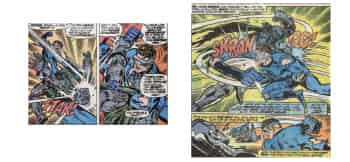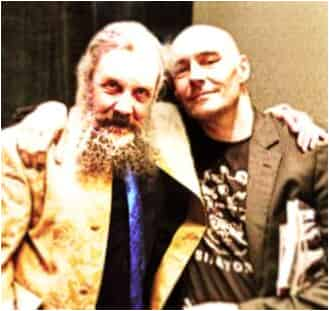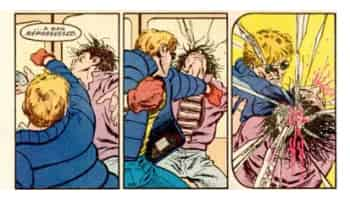
Alan Moore
The creative process is a conversation
We all know that, today, almost every story has already been told. And art doesn’t arise out of nothingness. Writers, painters, directors and other artists create their work in communion with their environment. So we admire a director like Quentin Tarantino who’s not afraid to announce his influences.
Andrew Wheeler says it well: “Star Wars was inspired by Flash Gordon. A Song of Ice and Fire owes a debt to The Lord of the Rings. Harry Potter offers an answer to The Chronicles of Narnia. Breaking Bad takes its lead from The Godfather. Jason Bourne took shape against James Bond.
“Art exists in conversation with that which came before it, and that’s as true in comics as in any other narrative form. […]Everyone who tells stories or creates art is a critical thinker, responding to ideas with ideas of their own. There aren’t just two types of people. Makers are critics.” (“‘If You Don’t Like It, Make Your Own’ Is a Terrible Argument, but a Great Idea,” http://comicsalliance.com, September 2, 2015).
So we don’t have any hang-ups about presenting what has inspired sections of our stories, or even whole stories.
What’s troubling though is unintentional borrowing. It is possible that certain parts of a given film or novel made an impression, without us remembering it explicitly. Kate Willaert talks about this phenomenon: “Being such a huge Jack Kirby fan, is it possible Alan Moore read this story at some point and simply forgot about it? Or for that matter, could The Architects Of Fear writer Meyer Dolinksy have read it?
“A creator forgetting they encountered an idea elsewhere isn’t an uncommon phenomenon, especially in the music world. Paul McCartney has a famous story about how while writing “Yesterday,” he became paranoid that he might’ve accidentally nicked it from somewhere. After playing it for just about everyone he knew and no one saying they recognized it, he felt confident that it was completely original.” (“Did Watchmen Steal From the Outer Limits, Or From Jack Kirby?” http://www.comicsbeat.com, August 10, 2015).
In a world like ours, we really have to stop looking for plagiarism. We should admit our influences and honour them. The word plagiarism should only be applied to outright copying, and not to borrowing. Otherwise, we could never again see any of Tarantino’s movies.
How far to go with character descriptions?
We came across this review of issue 7 of the Miracleman series that we found quite compelling:
Overall, the primary content of this issue is still quite excellent. Once again Cream is a confounding influence and the art does see a decline in quality, but the story is still very engaging and I’m honestly intrigued to see how Moran gets himself out of this mess. You see, Gargunza used the term “Abraxas” to turn Miracleman back into Moran. The word keeps him in his human state for an hour. He and Cream are then given a head start to run away from Miracledog before he is sicced on them. Cream hands Moran a gun before running off to be decapitated by Miracledog. The issue ends on a very human and very scared Moran confronted by the beast. I have no idea how he can save himself but I’m excited to find out. » (Michael Brown, “Marvel’s Miracleman # 7: Enter Chuck Austen,” comicbook.com, June 6, 2014)
There is a fine line to walk between giving a full character profile and maintaining an aura of mystery that leaves some interpretation to the reader. It’s a very fine line. Personally, we don’t like to over-explain the psychological choices of our characters, but we don’t want to neglect concrete actions either. The line is even harder to identify since we don’t always know where certain actions will lead. For example, at the start, Fabien didn’t want to sleep. But later, we saw that his former teammates were appearing in his nightmares. Then he started hearing voices. These events were layered one on top of the other without advance planning. However, they culminated in the story “Psychological Warfare.” While authors may be surprised by the twists and turns they themselves create, they should not leave the reader struggling to keep up.
Comic books from the 70s
A lot of people judge American comic book writers from the 1970s harshly. Alan Moore was one of the fiercest critics of the early 80s. (“Alan Moore’s Lost Stan Lee Essay,” 1983, part 2 of 2). We consider the Silver Age to be a period in which the various elements in comic books were kept in check. The dialogue wasn’t overly explanatory, the descriptive boxes offered access to another level of story, and we hadn’t yet sunk to psychologically hyperanalyzing the characters. Here is a page from issue 200 of the Fantastic Four, written by Marv Wolfman, where we find such a balance.
Ideas floating in the air– Part II
A discussion took place on the web about Alan Moore having “borrowed” for a Superman story that was allegedly inspired by Grant Morrison’s Superfolks series. The author of this piece theorizes that Alan Moore may have unconsciously drawn from ideas that had struck him many years before (“Alan Moore and Superfolks Part 2: The Case for the Defence,” comcisbeat.com, November 11, 2012). In our story, “World’s Best Friends,” Benson makes a comment about his father’s upcoming death. It was only months after writing the story that we remembered that the inspiration for that conversation came from a short story in Daniel Poliquin’s collection, Le Canon des Gobelins.
Which tone to use?
Corey Schroeder reminds us that “Fast-forward to the 90s and you’ve got a new kind of Batman. Watchmen and The Dark Knight Returns have reinvented superheroes as real people with real flaws in the midst of stories that treat the audience’s intellect with maturity” (“Are Superhero Comics Too Serious,” www.comicvine.com, September 14, 2011). Chris Sims goes even further: “The imitators learned the wrong lessons, and instead of creating stories that treated their subject matter with intelligence and craft, which is a difficult matter requiring a great deal of skill, the knock-offs tried to recapture the things that were easy, like cussin’ and violence. They were exactly the same kind of escapist power fantasy that they were pretending to rise above, just wrapped up in cheap, meaningless exploitation and sold to the audience as something that wasn’t for little kids — which in itself is the most immature, teenage motivation something can possibly have” (“What’s Up with the 90s?” www.comicsalliance.com, July 27, 2012).
This may explain why some people wonder if superhero stories have become too violent (“Sex & Violence,” www.comicbookdaily.com, December 9, 2011). In our opinion, violence isn’t the real problem. In the 90s, Frank Miller’s Daredevil stories included some very graphic representations of violence. But they fit the mood. Our main reproach would be the lack of perspective about that violence. If we take the TV series 24, Jack Bauer tortured criminals but we don’t recall any innocent characters being tortured. We feel more uneasy about that situation than about the torture itself.
Writing and Political Opinion (Part I)
The release of the last Batman (The Dark Knight Rises) triggered a fierce media debate about Christopher Nolan’s political intentions. Was his Batman defending against the values of conservatism? The hysteria reached its peak when the villain’s name, Bane, was associated with the name of a company founded by Mitt Romney (Baine Capital). Chuck Dixon, the co-creator of Bane, had to make a public statement to declare his conservative beliefs (Jozef Siroka, « Batman ne porterait pas le carré rouge », www.lapresse.ca, July 24, 2012).
This is reminiscent of when Frank Miller harshly denounced the Occupy movement, a position that was then criticized (Brent Chittenden, “Oh Frank Miller… Creators and Politics,” November 17, 2011, www.comicbookdaily.com “Watchmen Writer Alan Moore Set to Occupy Comics After Spat With Frank Miller”, www.geeksofdoom, December 6th, 2011). However, as Sara Lima pointed out, V for Vendetta remains an excellent comic even if Alan Moore claims anarchy as the best form of government (“Do Politics in Comics Alienate Readers?” www.comicvine.com, October 6, 2011).
We feel that a work of art should never be crushed under the weight of political or social metaphor. Otherwise, the characters become unmoored from reality and their sole purpose is to be spokesmen for the author. Authors who want to deliver a strong social or political message should consider essay writing.
Alan Moore
Citing the influence of Alan Moore is a cliché in the world of comic books because he had such an impact on comic-book narration. We will confess to not having read his classic “Watchmen” or “V for Vendetta” series. But the first nine issues of his “Miracleman” had a profound impact on our story construction. We could talk about this at length, but this review taken from the French comics website www.sceneario.com says it all: “Moore writes with a great deal of finesse, playing with monologues, thoughts, voice-offs, etc. He brings the reader into a very realistic, very dark and disappointed world… What has happened to our childhood heroes? [translation]”









